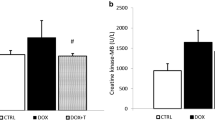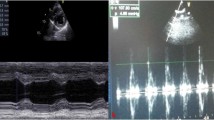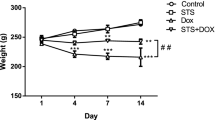Abstract
The amino acids histidine and n-acetylcysteine have many biological activities such as antioxidant effect. The present study investigated the effects of histidine and n-acetylcysteine on the heart lesions induced by doxorubicin (DOX) in rats. Forty-eight male Wistar rats were divided into two major groups treated intraperitoneally (i.p.) with normal saline and 4 mg/kg of DOX, respectively. Each group was further divided into four subgroups that were treated with separate and combined i.p. injections of histidine and n-acetylcysteine (NAC) at a same dose of 40 mg/kg. Electrocardiography (ECG) was recorded using lead II. The heart lesions were evaluated by light microscopy. Serum levels of creatine phosphokinase and lactate dehydrogenase and heart tissue malondialdehyde levels were measured. Histidine and especially NAC at a same dose of 40 mg/kg recovered ECG changes, improved heart lesions and prevented biochemical changes induced by DOX. Co-administration of histidine and NAC showed better responses when compared with them used alone. The results of the present study showed protective effects for histidine and NAC on the heart. Reduction in free radical-induced toxic effects may be involved in cardioprotective properties of histidine and NAC.





Similar content being viewed by others
References
Minotti, G., Menna, P., Salvatorelli, E., Cairo, G., & Gianni, L. (2004). Anthracyclines: Molecular advances and pharmacologic developments in antitumor activity and cardiotoxicity. Pharmacological Review, 56, 185–229.
Singal, P. K., & Iliskovic, N. (1998). Doxorubicin-induced cardiomyopathy. New England Journal of Medicine, 339, 900–905.
Simunek, T., Sterba, M., Popelova, O., Adancova, M., Hrdina, R., & Gersl, V. (2009). Anthracycline-induced cardiotoxicity: Overview of studies examining the roles of oxidative stress and free cellular iron. Pharmacological Reports, 91, 154–171.
Octavia, Y., Tocchetti, C. G., Gabrielson, K. L., Janssens, S., Crijins, H. J., & Moens, A. L. (2012). Doxorubicin-induced cardiomyopathy: From molecular mechanisms to therapeutic strategies. Journal of Molecular and Cellular Cardiology, 52, 1213–1225.
Volkova, M., & Russell, R, 3rd. (2011). Anthracycline cardiotoxicity: Prevalence, pathogenesis and treatment. Current Cardiology Reviews, 7, 214–220.
Ito, T., Muraoka, S., Takahashi, K., Fujio, Y., Schaffer, W., & Azuma, J. (2009). Beneficial effects of taurine treatment against doxorubicin-induced cardiotoxicity in mice. Advances in Experimental Medicine and Biology, 643, 65–74.
Todorova, V. K., Kaufmann, Y., Hennings, L., & Kimberg, V. S. (2010). Oral glutamine protects against acute doxorubicin-induced cardiotoxicity in tumor-bearing rats. Journal of Nutrition, 140, 44–48.
Farshid, A. A., Tamaddonfard, E., Belasius, M. S., & Hamzeh-Gooshchi, N. (2009). Histopathological comparison of the effects of histidine and ketotifen in a rat model of colitis. Bulletin of the Veterinary Institute in Pulawy, 53, 795–800.
Farshid, A. A., Tamaddonfard, E., & Morvaridi, A. (2011). Effects of histidine and dexamethasone on the local inflammation induced by histamine in rats. Veterinary Research Forum, 2, 31–36.
Farshid, A. A., Tamaddonfard, E., & Ranjbar, S. (2013). Oral administration of vitamin C and histidine attenuate cyclophosphamide-induced hemorrhagic cystitis in rats. Indian Journal of Pharmacology, 45, 126–129.
Farshid, A. A., Tamaddonfard, E., & Yahyaee, F. (2010). Effects of histidine and N-acetylcysteine on diclofenac-induced anti-inflammatory response in acute inflammation in rats. Indian Journal of Experimental Biology, 48, 1136–1142.
Tamaddonfard, E., & Rahimi, S. (2004). Central effect of histamine and peripheral effect of histidine on the formalin-induced pain responses in mice. Clinical and Experimental Pharmacology and Physiology, 31, 518–522.
Wade, A. M., & Tucker, H. N. (1998). Antioxidant characteristics of L-histidine. The Journal of Nutritional Biochemistry, 9, 308–315.
Obata, T., Aomine, M., & Yamanaka, Y. (1999). Protective effect of histidine on iron (II)-induced hydroxyl radical generation in rat hearts. Journal of Physiology (Paris), 93, 216–218.
Kelly, G. S. (1998). Clinical application of N-acetylcysteine. Alternative Medicine Review, 3, 114–127.
Doroshow, J. H., Locker, G. Y., Ifrim, I., & Myers, C. E. (1981). Prevention of doxorubicin cardiac toxicity in the mouse by N-acetylcysteine. The Journal of Clinical Investigation, 68, 1053–1064.
Arica, V., Demir, I. H., Tutanc, M., Barsarslan, F., Arica, S., Karcoiglu, M., et al. (2013). N-acetylcysteine prevents doxorubicin-induced cardiotoxicity in rats. Human and Experimental Toxicology, 32, 655–661.
Singh, D. K., & Lippman, S. M. (1998). Cancer chemoprevention part 1: Retinoids and carotenoids and other classic antioxidants. Oncology, 12, 1643–1660.
Bayne, K. (1996). Revised, guide for the care and use of laboratory animals. American physiological society. Physiologist, 39, 208–211.
Clark, J. D., Gebhart, G. F., Conder, J. C., Keeling, M. E., & Kohn, D. F. (1997). Special report: The 1996 guide for the care and use of laboratory animals. Institute of Laboratory Animals Research Journal, 38, 41–48.
Xin, Y. F., Zhou, G. L., Deng, Z. Y., Chen, Y. X., Wu, Y. G., Xu, P. S., et al. (2007). Protective effect of Lycium barbarum on doxorubicin-induced cardiotoxicity. Phytotherapy Research, 21, 1020–1024.
Kolarovic, J., Popovic, M., Zlinska, J., Trivic, S., & Vojnovic, M. (2010). Antioxidant activity of celery and parseley in rats treated with doxorubicin. Molecules, 15, 6193–6204.
Tariq, M., Morais, C., Soki, S., Al Sulaiman, M., & Al Khader, A. (1999). N-acetylcysteine attenuates cyclosporine-induced nephrotoxicity in rats. Nephrology, Dialysis, Transplantation, 14, 923–929.
Kakulavarapu, V., Rao, R., Reddy, P. V. B., Tong, X., & Norenberg, M. D. (2010). Brain edema in acute liver failure: Inhibition by L-histidine. American Journal of Pathology, 176, 1400–1408.
Farraj, A. K., Hazari, M. S., & Cascio, W. E. (2011). The utility of the small rodent electrocardiogram in toxicity. Toxicological Sciences, 121, 11–30.
Ammar, E.-S. M., Said, S. A., El-Damarawy, S. L., & Suddek, G. M. (2013). Cardioprotective effect of grape-seed proanthocyanidins on doxorubicin-induced cardiac toxicity in rats. Pharmaceutical Biology, 51, 339–344.
Ohkawa, H., Ohishi, N., & Yagi, K. (1979). Assay of lipid peroxidase in normal tissue by thiobarbituric acid reaction. Analytical Biochemistry, 95, 351–358.
Jensen, R. A., Acton, E. M., & Peters, J. H. (1984). Electrocardiographic and transmembrane potential effects of 5-iminodaunorubicin in the rat. Cancer Research, 44, 4030–4039.
Shan, S., Mohan, M. M., Kasture, S., Sanna, C., & Maxia, A. (2009). Protective effect of Ephedra nebrodensis on doxorubicin-induced cardiotoxicity in rats. Iranian Journal of Pharmacology and Therapeutics, 8, 61–66.
van Acker, S. A., Kramer, K., Voest, E. E., Grimbergen, J. A., Zhang, J., van der Vijgh, W. J., et al. (1996). Doxorubicin-induced cardiotoxicity monitored by ECG in freely moving mice. A new model to test potential protectors. Cancer Chemotherapy and Pharmacology, 38, 95–101.
Dudka, J., Gieroba, R., Korga, A., Burdan, F., Matysiak, W., Jodlowska-Jedrich, B., et al. (2012). Different effects of resveratrol on dose-related doxorubicin-induced heart and liver toxicity. Evidence Based Complementary and Alternative Medicine, 2012, 606183. doi:10.1155/2012/606183.
Abd Elbaky, A. N., Ali, A. A., & Ahmed, R. A. (2010). Cardioprotective effect of simvastatin on doxorubicin-induced oxidative cardiotoxicity in rats. Journal of Basic and Applied Sciences, 6, 29–38.
Yagamura, M., Fadillioglu, E., & Erdogan, H. (2003). Erdosteine prevents doxorubicin-induced cardiotoxicity in rats. Pharmacological Research, 48, 377–382.
Xu, M. F., Tang, P. L., Qian, Z. M., & Ashraf, M. (2001). Effects by doxorubicin on the myocardium are mediated by oxygen free radicals. Life Sciences, 68, 889–901.
Koti, B. C., Vishwanathswamy, A. H. M., Wagawade, J., & Thippeswamy, A. H. M. (2009). Cardioprotective effect of lipistat against doxorubicin induced myocardial toxicity in albino rats. Indian Journal of Experimental Biology, 47, 41–46.
Mokni, M., Hamlaoui-Guesmi, S., Amir, M., Marzuki, L., Limam, F., & Aouan, E. (2012). Grape seed and skin extract protects against acute chemotherapy toxicity induced by doxorubicin in rat heart. Cardiovascular Toxicology, 12, 158–165.
Lebrecht, D., Geist, A., Ketelsen, U. P., Haberstroh, J., Setzer, B., & Walker, U. A. (2007). Dexrazoxane prevents doxorubicin-induced long-term cardiotoxicity and protect myocardial mitochondria from genetic and functional lesions in rats. British Journal of Pharmacology, 151, 771–778.
Moore, K., & Roberts, L. J. (1998). Measurement of lipid peroxidation. Free Radical Research, 28, 659–671.
Chatterjee, A., Zhang, J., Honbo, N., & Karliner, J. S. (2010). Doxorubicin cardiotoxicity. Cardiology, 115, 155–162.
Lee, Y. T., Hsu, C. C., Lin, M. H., Liu, K. S., & Yin, M. C. (2005). Histidine and carnosine delay diabetic deterioration in mice and protect human low density lipoprotein against oxidation and glycation. European Journal of Pharmacology, 513, 145–150.
Li, S. Q., Zhao, G., Li, J., & Qian, W. (1998). Effect of histidine on myocardial mitochondria and platelet aggregation during thrombic cerebral ischemia in rats. Zhongguo Yao Li Xu Bao, 19, 493–496.
Cai, Q., Takemura, G., & Ashraf, M. (1995). Antioxidative properties of histidine and its effect on myocardial injury during ischemia/reperfusion in isolated rat heart. Journal of Cardiovascular Pharmacology, 25, 147–155.
Villani, F., Galimberti, M., Monti, E., Piccinini, F., Lanza, E., Rozza, A., et al. (1990). Effect of glutathione and N-acetylcysteine on in vitro and in vivo cardiac toxicity of doxorubicin. Free Radical Research Communications, 11, 145–151.
Powell, S. R., & McCay, P. B. (1988). Inhibition of doxorubicin-initiated membrane damage by N-acetylcysteine: possible mediation by a thiol-dependent, cytosolic inhibitor of lipid peroxidation. Toxicology and Applied Pharmacology, 96, 175–184.
Park, E. S., Kim, S. D., Lee, M. H., Lee, H. S., Lee, I. S., Sung, J. K., et al. (2003). Protective effect of N-acetylcysteine and selenium against doxorubicin toxicity in rats. Journal of Veterinary Science, 4, 129–136.
Kockar, M. C., Naziroglu, M., Celik, O., Tola, H. T., Bayram, D., & Koyu, A. (2010). N-acetylcysteine modulates doxorubicin-induced oxidative stress and antioxidant vitamin concentrations in liver of rats. Cell Biochemistry and Function, 28, 673–677.
Dobrzynska, I., Skrzydlewska, E., Kasacka, I., & Figaszewiski, Z. (2000). Protective effect of N-acetylcysteine on rat liver cell membrane during methanol intoxication. Journal of Pharmacy and Pharmacology, 52, 547–552.
Peterson, J. W., Boldogh, I., Popov, P. L., Saini, S. S., & Chopra, A. K. (1998). Anti-inflammatory and antisecretory potential of histidine in salmonella challenged mouse small intestine. Laboratory Investigation, 78, 523–534.
Lamson, D. W., & Brignall, M. S. (1999). Antioxidants in cancer therapy: Their actions and interactions with oncologic therapies. Alternative Medicine Review, 4, 304–329.
Kalaiselvi, P., Pragasam, V., Chinnikishnan, S., Veera, C. K., Sundarapandiyan, R., & Varalakshmi, P. (2005). Counteracting adriamycin-induced oxidative stress by administration of N-acetylcysteine and vitamin E. Clinical Chemistry and Laboratory Medicine, 43, 834–840.
Acknowledgments
This work was supported by the Faculty of Veterinary Medicine, Urmia University, Urmia, Iran.
Author information
Authors and Affiliations
Corresponding author
Rights and permissions
About this article
Cite this article
Farshid, A.A., Tamaddonfard, E., Simaee, N. et al. Effects of Histidine and N-Acetylcysteine on Doxorubicin-Induced Cardiomyopathy in Rats. Cardiovasc Toxicol 14, 153–161 (2014). https://doi.org/10.1007/s12012-013-9239-6
Published:
Issue Date:
DOI: https://doi.org/10.1007/s12012-013-9239-6




